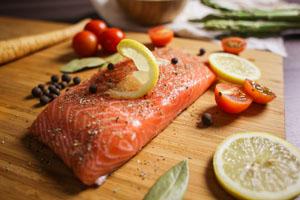
How to Go Grain-Free as a Lyme Patient
When I first met my future husband, he was a die-hard yogi vegetarian of 20 years. I had opted for a vegetarian diet as well for 12 years throughout my 20’s, but had decided to include clean meat once again after attending survival school and spending time “living primitively.”
Yet once Jeffrey and I began living together, the necessary division of labor became clear – I cooked, and he cleaned. And since he was very committed to vegetarianism, I happily re-learned how to cook and eat this way.
After Lyme disease and antibiotics hit Jeffrey, eating food was no longer a simple matter.
Very often, a healthy vegetarian meal – such as brown rice, lentils, and kale – would set off a fever, an energy crash, or a wave of indigestion that could last for hours or days.
We began to try eliminating many different things – we went dairy-free, gluten-free, alcohol-free, and sugar-free. Each change seemed to help a bit, but inevitably, before long some food would trigger another setback. Trying to pin down all of his food sensitivities was confusing, and felt like a lot of effort for disappointing results.
It was nearly a year before I discovered the Lyme-associated disease Small Intestine Bacterial Overgrowth (SIBO). SIBO occurs when antibiotics (or other causes) diminish the good bacteria of the small intestine, and encourage the overgrowth of disease causing bacteria to proliferate.
 This leads to excessive amounts of gas in the body, and many other digestive and systemic symptoms, such as diarrhea, constipation, malabsorption of nutrients, and inflammation.
This leads to excessive amounts of gas in the body, and many other digestive and systemic symptoms, such as diarrhea, constipation, malabsorption of nutrients, and inflammation.
Healing SIBO requires going grain-free – not welcome news for a committed vegetarian. But Jeffrey had been suffering for so long, he was willing to try anything – including eating meat.
That’s when my quest for cooking grain-free meals began.
The truth is, the grains of the modern diet are now understood to contribute significantly to the modern infectious and inflammatory disease epidemics of our times – from diabetes and being overweight to chronic yeast and Lyme infection to joint or muscle pains, and much more. These days, I’m hard pressed to find a person in my clinic who wouldn’t benefit from going grain-free.
 But life without grains can seem almost unimaginable. After all, what’s a burger without the bun? A sandwich without the bread? Pizza without the crust?!
But life without grains can seem almost unimaginable. After all, what’s a burger without the bun? A sandwich without the bread? Pizza without the crust?!
Before you get completely overwhelmed, read what’s below – the 5 most important things to do when going grain-free.
1. What will you miss the most? Look for grain-free substitutes for the foods and meals that you will miss the most. Try romaine lettuce instead of a flour wrap; red lentil pasta over wheat or rice pasta (I recommend Tolerance brand – it’s new on the market and the taste and texture is great!) – you get the picture.
2. Plan, plan, and plan some more. For a little while, focus on what you’re going to eat ahead of time, and shop and cook accordingly so that the food you need is there for you. Some favorite resources for recipes include:
www.elanaspantry.com
www.wellnessmama.com
http://www.huffingtonpost.com/merry-kuchle/30-grain-free-recipes-tha_b_6449102.html
 3. Pick a day where you focus on making extra food for the week. For many of us, it’s Sunday. If I’m making a soup, a pot of Indian dahl, paleo muffins, sweet potato pancakes, or a casserole, I’ll make extra so that there is plenty to take to work, to grab for quick dinners when I come home late and am too tired to get creative from scratch in the kitchen. (pic: healthy broccoli pie)
3. Pick a day where you focus on making extra food for the week. For many of us, it’s Sunday. If I’m making a soup, a pot of Indian dahl, paleo muffins, sweet potato pancakes, or a casserole, I’ll make extra so that there is plenty to take to work, to grab for quick dinners when I come home late and am too tired to get creative from scratch in the kitchen. (pic: healthy broccoli pie)
4. Keep a food journal or simply pay close attention to how you feel following grain-free meals, versus how you feel after eating grains. When feeling gassy, bloated, fatigued, and sick is clearly a result of eating grains, that provides strong motivation for sticking with the program.
5. Use a crock pot. Beans, chicken or roast in a crock pot is a simple way to make a hearty dinner. All that’s left to do is make a fresh salad, and dinner is ready! Plus, there’s always leftovers for salads, soups, and as a side.
You can do this, and these simple tricks will take you far in supporting a successful transition to a grain-free diet.
Over time you will miss breads and other common grain-based foods less and less. You will know what you like and what works for you that’s grain-free instead.
Beginning is the hardest part! So read this article once more, and if you feel this diet is right for you then take your first step. You will soon begin to feel better!
If you are wanting holistic treatment for Lyme or other similar complex chronic diseases, simply call us at 845-687-6211 or email info@uprootinglyme.com to set up an in-person or virtual holistic Lyme consultation at reasonable rates. Together we’ll co-create a strategic holistic treatment plan. Receive the support and guidance you need to regain your health, strength and resilience. Contact us now!





